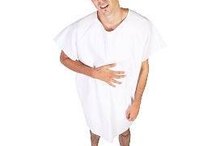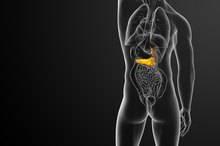Cholesterolosis of the Gallbladder Symptoms
Cholesterolosis is the accumulation of cholesterol in the cells lining the gallbladder wall, the submucosal macrophages 12. The condition often occurs seen when the gall bladder from a person suffering from gallstones, or cholelithiasis, is dissected. The accumulated fatty substance causes raised, discolored spots on the gallbladder surface, leading to the descriptive pathological term “strawberry gallbladder." The condition does not produce clinical symptoms and is considered a pathological anomaly, though clinical trials have attempted to uncover the cause of the condition due to its potential association with gallstones. Gallstones are small pebble-like accumulations of cholesterol and bile inside the gall bladder, leading to sudden pain and intestinal discomfort.
If you are experiencing serious medical symptoms, seek emergency treatment immediately.
Abdominal and Back Pain
A gallbladder attack occurs when a stone clogs the bile duct, increasing the pressure inside the gallbladder. The pain comes on suddenly, sometimes following fatty meals and occurring during the night. The most common locations to experience gallbladder-related pain occur in the right upper abdomen, between the shoulder blades in the back and under the right shoulder reports the National Institute of Diabetes and Digestive and Kidney Diseases or NIDDK. The pain may increase rapidly for 30 minutes to several hours. The “attack” passes as the stone moves.
- A gallbladder attack occurs when a stone clogs the bile duct, increasing the pressure inside the gallbladder.
- The pain comes on suddenly, sometimes following fatty meals and occurring during the night.
Clay-colored Stool
Side Effects of Gallstones
Learn More
The lack of bile released into the gastrointestinal tract from the gallbladder may result in clay colored stools. Though changes in stool color occur normally with changes in diet and nutrition, the color results because of the presence of bile, which is light yellow to black in color. The NIDDK says that gray or clay-colored stool indicate a lack of bile flow, suggesting a blockage of the intestinal tract or gall bladder
Subtle Symptoms
Gallstones and complications from gall bladder attacks can cause some common intestinal and infection symptoms. A rupture of the bile duct due to the blockage or increased bile in the gallbladder can cause a low grade fever or chills, as well as yellowing of the eyes and skin, called jaundice, states the NIDDK. The intestinal discomfort may result in nausea and vomiting. Because the symptoms mimic other disorders, such as heart attack and strained back muscles, it is important to seek medical advice.
- Gallstones and complications from gall bladder attacks can cause some common intestinal and infection symptoms.
Asymptomatic
Gallbladder Infection Symptoms
Learn More
According to the NIDDK, many people have “silent stones” and experience no symptoms. Cholesterolosis of the gallbladder, with or without gall stones, is also asymptomatic 1.
Related Articles
References
- Medcyclioaedia: Cholesterolosis
- ClinicalTrials.gov: Gallbladder cholesterolosis, body mass index and serum cholesterol and triglycerides
- Jones MW, Ferguson T. Chronic Cholecystitis. In: StatPearls [Internet]. Treasure Island (FL): StatPearls Publishing; 2019 Jan-.
- Stinton LM, Shaffer EA. Epidemiology of gallbladder disease: cholelithiasis and cancer. Gut Liver. 2012;6(2):172-87. doi:10.5009/gnl.2012.6.2.172
- Lamberts MP. Indications of cholecystectomy in gallstone disease. Curr Opin Gastroenterol. 2018;34(2):97-102. doi:10.1097/MOG.0000000000000419
- Jones MW, Ferguson T. Acalculous Cholecystitis. In: StatPearls. Treasure Island (FL): StatPearls Publishing; 2019 Jan-.
- Abraham S, Rivero HG, Erlikh IV, Griffith LF, Kondamudi VK. Surgical and nonsurgical management of gallstones. Am Fam Physician. 2014;89(10):795-802.
- University of Maryland Medical Center. (2012, August 26). Gallstones and gallbladder disease.
Writer Bio
Alicia Prater has been a full-time scientific editor and writer since 2008 and has contributed to many online publishers on a range of topics. Her preliminary dissertation work contributed to a peer-reviewed paper published in the "American Journal of Hypertension" in 2006. Prater received her Ph.D. in experimental pathology from New York Medical College.








